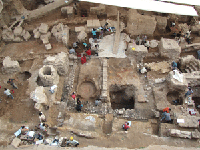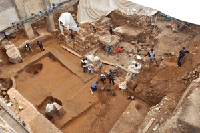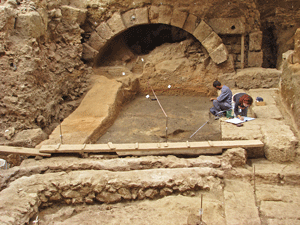
As the modern city rises, archaeologists uncover evidence of its complex history and changing fortunes

Across Beirut, archaeologists are uncovering centuries of evidence clarifying the city's long and complicated history. In the Riad el Solh area downtown, the remains of a massive 1st-century A.D. Roman wall that may once have been more than 20 feet wide are visible.
(Courtesy Directorate General of Antiquities, Ministry of Culture, Lebanon)
"This city is one of those that must live and relive, come what may," wrote the nineteenth-century French geographer Élisée Reclus. "The conquerors pass on and the city is reborn behind them." Phoenician port, Roman beachhead, Byzantine lawgiver, Ottoman backwater, and Paris of the Middle East, Beirut has been an urban chameleon. In the past century alone, it morphed from the center of Arab culture, intrigue, and nightlife into a symbol of sectarian strife as a 15-year civil war laid waste to its boulevards and buildings. "Beirut is a phenomenon, beguiling perhaps, but quite, quite impossible," concludes British writer Jan Morris.
Even as Beirut reinvents itself yet again—this time as a skyscraper-studded center of finance—a new generation of young Lebanese archaeologists is fighting to reclaim the city's complicated past before it is gone for good. In the rush to build during the past decade, Roman ruins were bulldozed, columns were crushed into cement, and piles of ancient debris were relegated to the city dump. Now a small army of some 50 excavators and hundreds of workers are attempting to stay one step ahead of the luxury condos and office towers that threaten to wipe away what's left of Beirut's ancient remains. No longer dependent on the foreign experts who once dominated Lebanese archaeology, this group is forging agreements with developers to conduct extensive rescue excavations. "There has been a void, but now we are taking responsibility for our own heritage," says Assaad Seif, the acting chief of Lebanon's state department of archaeology.
What we know of Beirut's ancient history is more a series of snapshots than a continuous record. Sixty thousand years ago, early humans made stone tools on the tongue of land that extends out from the Lebanon Mountains and forms the city's modern boundaries. Archaeologists have uncovered a small Neolithic village dating to 4000 B.C. near today's airport. As civilization emerged in the third millennium B.C., the first major cities along the Mediterranean coast took root nearby. Byblos, now a half-hour drive up the coast, flourished, while Tyre and Sidon grew to the south. These important ports became centers for the seafaring Phoenicians, a trading people who spread across the region between the sixteenth and fourth centuries B.C.


Downtown, excavations are uncovering not only the city's ancient Roman history (top), but also evidence for earlier periods, especially in the area of the city
wall (bottom).
(Courtesy Directorate General of Antiquities, Ministry of Culture, Lebanon)
But Beirut seems to have been a rather unimportant town in that period. A modest Phoenician seawall dates to 700 B.C., and invading Persians wrecked and then rebuilt the town on a grid plan in the fourth century B.C. A small cluster of 16 houses from that era was recently uncovered when the nineteenth-century marketplace was demolished and rebuilt. Even the fifth-century B.C. Greek traveler and historian Herodotus overlooked Beirut, despite mentioning other cities, including Tyre and Sidon, in the area. Two centuries later, these were important prizes for Alexander the Great, whereas the chronicles of the general's campaigns in the region in 332 B.C. do not even
mention Beirut.
It was the expansion of the Roman Empire in the first century B.C. that finally gave Beirut a chance to outshine its more famous rivals. The city lacked a good harbor, but it did have a bay that could shelter a large number of ships. In 31 B.C., the Roman general Marc Antony's fleet lay at anchor here, and his ally and lover, the Egyptian queen Cleopatra, had coins stamped in her likeness at a Beirut mint as well. But that same year Octavian—soon to be the emperor Augustus—defeated both at the Battle of Actium in Greece. The emperor then chose Beirut as a beachhead for Roman domination of the East. Unlike the larger and more established cities of Tyre or Sidon, Beirut proved friendly to the outsiders. The tough tribes living in the Lebanon Mountains had long plagued the city, and Beirut's inhabitants welcomed two Roman legions as protection. Augustus also settled Roman veterans here, and turned Beirut into a colonia, or tax-free zone.
With the cooperation of the Judean king Herod Agrippa I, the emperor built forums, temples, a hippodrome, colonnades, roads, and aqueducts in what had once been a modest town. The first-century A.D. Jewish historian Josephus says Herod had a magnificent amphitheater built where 1,400 gladiators were pitted against one another in a single day. His son, Herod Agrippa II, continued that patronage, inciting jealousy from the Judean cities to the south, according to Josephus. The historian adds that Jewish rebels were burned, forced to fight, or thrown to wild animals in the amphitheater following their uprising, which led to Jerusalem's destruction in A.D. 70.
With prosperity, the arts and intellectual life flourished. By the third century A.D., Beirut was "the center for the teaching of Roman law," according to Gregory Thaumaturgus, a Christian writer of the time. Rome and the Byzantine capital of Constantinople (modern Istanbul) also had law schools, but contemporary texts show that Beirut quickly became the place to go in the East to study law. Within a century, the chronicler Libanius praised the city as "mother of the laws."

In the Jemmayzé area east of downtown Beirut, archaeologists have uncovered a large caldarium, the room of an ancient Roman bathing complex where the hot plunge was located. Water was heated by circulating hot air under the floor around small columns like those seen below.

(Courtesy Directorate General of Antiquities, Ministry of Culture, Lebanon)
Unlike the famous ancient library of Alexandria in Egypt, which was mostly destroyed during the bitter fights between pagans and Christians, Beirut's law school survived and prospered, despite the church's suspicion of non-biblical learning. As the Roman Empire collapsed in the West, the Byzantine Empire emerged as its heir in the East during the fifth century A.D. Beirut, strategically located between Constantinople and Alexandria, was the focal point of imperial rule. The lawyers of Beirut proved well-equipped to interpret imperial decrees and set codes of justice for the Byzantines. When the emperor Justinian called for reform of the legal codes, he turned to Beirut's scholars to oversee the revision.
The new code's publication in A.D. 533 marked the heyday of Beirut's intellectual influence. But on a July day in A.D. 551, an earthquake registering an estimated 7.6 on the Richter scale rocked the city, killing tens of thousands of people and toppling most of its monuments and buildings. The law school moved to hated rival Sidon. In the following centuries, Arab armies, Crusader knights, and Mamluk rulers captured Beirut in succession. The Ottomans absorbed the town into their empire in the eighteenth century. By then, Beirut was the same sort of sleepy port town it had been before 31 B.C. Ottoman authorities later built the region's quarantine facility there, requiring all ships in the area to halt in port to contain the spread of disease. The city eventually attracted Western missionaries and commercial interests, putting it on a course for a renewed era of prosperity. Universities sprang up, a publishing industry grew, and an improved port and new road to Damascus gave Beirut the opportunity for a new start—until it was again destroyed, this time by civil war that lasted from 1975 to 1990.
The many layers of Beirut's occupation and destruction make the city a rich and complex archaeological site, but in the rush to rebuild after the war, archaeology was usually the loser. That started to change in 2005, when a new group of archaeologists led by Seif began to agitate for change. They called for enforcement of existing laws protecting ancient sites, tracked new construction projects, and negotiated agreements in which developers are obliged to pay for excavations, with the understanding that the scholars will have time limits to complete their work. Such contracts are common in many Western countries, but had not been widely practiced in Lebanon.
The scale of research now under way is unprecedented. One site being excavated by Fadi Beayno covers three acres in the heart of the old city. Here, in February 2011, work began on the development called "The District," touted on its website as "a city within a city," which will contain a total of two dozen buildings, including condos, penthouses, and retail areas. The site is located inside the Hellenistic and Roman city, but outside the smaller medieval town. As of now, only the construction materials from later Ottoman dwellings have been recovered. Any smaller remains, such as those from Neolithic times, are likely to go unnoticed.
Like other Lebanese excavators, Beayno was trained at a local university, but he has also worked with foreign teams, most of whom left by the late 1990s when the initial phase of reconstruction of the downtown area was completed. "From 1998 until 2005, there was a gap, there was no work," he recalls. Today, he and his colleagues are slowly assembling a mass of new data. "We are finally starting to understand the phases of occupation in Beirut," Beayno adds. Dating buildings in Beirut can be extremely challenging. As a result of the city's continuous occupation, stones from older buildings were frequently mined in later ages. Ottoman structures may include Hellenistic, Roman, and Byzantine elements. "In the later Ottoman period, you could get a permit to recoup stones," says Seif. "It was very well organized by professionals." This makes it difficult for archaeologists to piece together the city's appearance in any one period. However, tracing the expansion and contraction of the city is now conceivable. Landscape studies reveal a constantly shifting scene of urban, suburban, and rural environments. There are also surprising constants. "Many of the roads didn't change for 2,000 years," he says. Streets laid down in the Hellenistic period (fourth to first century B.C.) were still being used in the nineteenth century, and there is evidence that Roman engineers leveled hills and filled gullies in order to flatten the terrain to make building easier and regularize the street plan.
A few blocks west of "The District," on the edge of the ancient city, Beayno's wife, Christine, leads a team working on the site of what will be another luxury complex. They have already been excavating there for a year, and have only another eight months before construction begins in earnest.
Work at the 1.5-acre site, where they have cleared a 15-foot-deep rectangular hole, has already yielded the remains of a massive Roman wall dating to the first centuries A.D. Beirut was long thought not to have been fortified during the days when Rome's army enforced peace throughout the region. If this wall is identified as a fortification wall, it would be a great surprise. It is also possible that the wall was part of a monumental building. A small statue of Isocrates, a fourth-century B.C. Greek rhetorician much admired by later Roman lawgivers, was found nearby. "That's not a figure you would typically have in your family house," says Seif, during a visit to the site. "So there may be—and I'm cautious here—some connection with the law school." Pinpointing the location of the law school, the most famous of ancient Beirut's institutions, is one of the greatest quests among the city's archaeologists. Several sites have been suggested, based on evidence from texts and archaeological work, but nothing decisive has been uncovered.

Archaeologist Roula Reaidé cleans a Roman amphora in preparation for sampling and analyzing the carbonized material still inside.
(Courtesy Directorate General of Antiquities, Ministry of Culture, Lebanon)
On the eastern side of downtown, Hadi Choueri, the 31-year-old director of one of Beirut's most important excavations, is wrapping up work on a smaller site. After 15 months, the team has found a limestone Hellenistic wall from approximately the second century B.C. and a sandstone Roman wall from a few centuries later, each about nine feet wide and running parallel to each other. They were likely city walls, providing excavators with a way to sample life both inside and outside the city's boundaries. For example, a line of small single-room structures along a lane inside the Hellenistic wall could be remains of a shopping district from the early centuries B.C. Just outside the walls, anthropologist Freddie El Richani puzzles over an amphora that someone filled to the brim with small shells and carefully sealed underneath a floor some two millennia ago. The vessel may, he says, have been an offering of some sort. Nearby is another intriguing find: the grave of a young child with its skeleton intact, save for the lower leg bones. Analysis of these and other bones found in graves scattered around the site may reveal much about Beirut's early inhabitants, including the foods they ate and the diseases they suffered from.
Perhaps the most dramatic discovery here is of a collapsed stable dating to the Byzantine period. El Richani identified the remains of four donkeys against a wall, on top of each other, facing the same direction. All had died suddenly. A short distance away, the excavators found the skeletons of another three donkeys piled alongside a camel against a low wall. On top of one of the camel's bones was a coin made in Constantinople dating to A.D. 508. While not definitive evidence of the A.D. 551 earthquake, this new material may give archaeologists a chance to understand the calamity, which has only been known through textual sources.
The enormous amount of data being generated by the many excavations—six major ones were under way this past spring in the center of Beirut alone—is of great concern to Seif. The field archaeologists working for developers are paid to dig and record, but not to publish. The Lebanese government has so far not been willing to pay for the time and effort needed to do so. "I know that this is one of our most difficult challenges," says Seif. While some archaeologists are applying their fieldwork to advanced degrees, many are contract workers living from one job to the next, with no benefits and little time for, or experience with, the consuming job of publishing results. In the meantime, Beirut continues to boom, each new building potentially a lost opportunity to dig into the city's complex past. Most of the ruins will ultimately be destroyed to make way for parking garages mandated by law for the basements of the mammoth new buildings. But the results obtained by the archaeologists promise to transform both our understanding of the city and the way archaeology will be done in Lebanon in the future. "Much of the city's history is being discovered today. And contractors are changing their habits, and are willing to work with us," says Choueri. He and others say this is a welcome change. Beirut's archaeologists are always mindful of the demands of a city undergoing tremendous changes. As Fadi Beayno says, "In urban archaeology, you need to know when to use a brush and when to use a backhoe." And in a city that thrives on reinvention, archaeologists have to keep one step ahead of the next Beirut.
Andrew Lawler is a contributing editor to ARCHAEOLOGY.
Advertisement

Advertisement







